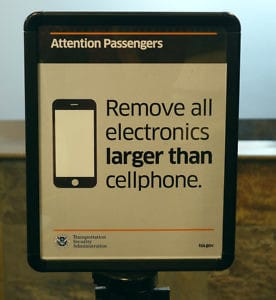 The Transportation Security Administration launched more comprehensive screening procedures on April 14 at airports around the country. These enhanced procedures have been in testing mode since last summer. They require travelers to place all personal electronics larger than a cell phone in separate bins for X-ray screening in standard lanes. This includes tablets, e-readers, and handheld game consoles.
The Transportation Security Administration launched more comprehensive screening procedures on April 14 at airports around the country. These enhanced procedures have been in testing mode since last summer. They require travelers to place all personal electronics larger than a cell phone in separate bins for X-ray screening in standard lanes. This includes tablets, e-readers, and handheld game consoles.
The TSA said these new procedures will help get clearer X-ray images.
Some travelers may also experience changes in what can be brought through security checkpoints. Food and liquid items complying with the 3-1-1 rule, electronics, and books are still allowed to be in carry-on baggage. However, TSA officials may instruct travelers to separate items such as foods, powders, and any materials that clutter bags and obstruct clear images on the X-ray machine.
TSA said travelers should organize their carry-on bags, so they aren’t’ cluttered to help keep lines moving. Items that can’t be identified at the checkpoint are prohibited from entering the aircraft cabin.
Passengers may experience more bag checks and additional screening of some items with these new procedures. TSA says this is for their own safety and officers should conduct screening with quicker, more targeted procedures. Travelers can also request a private screening.
These new rules don’t apply to travelers enrolled in TSAPre√®.



 Hi, ready to schedule a free consultation?
Hi, ready to schedule a free consultation?